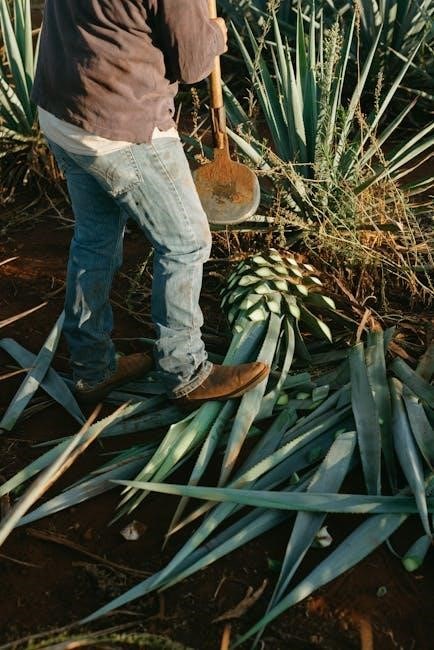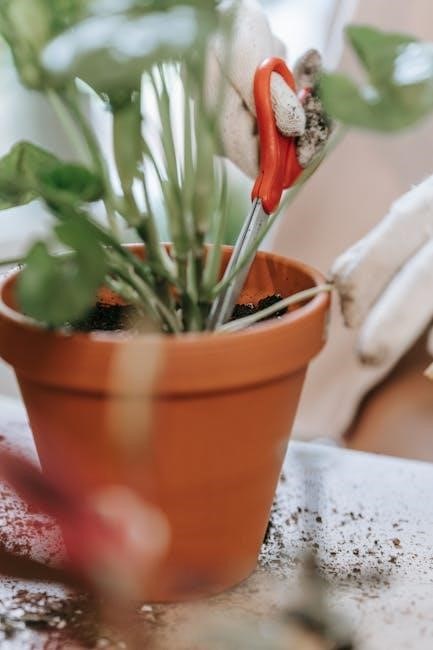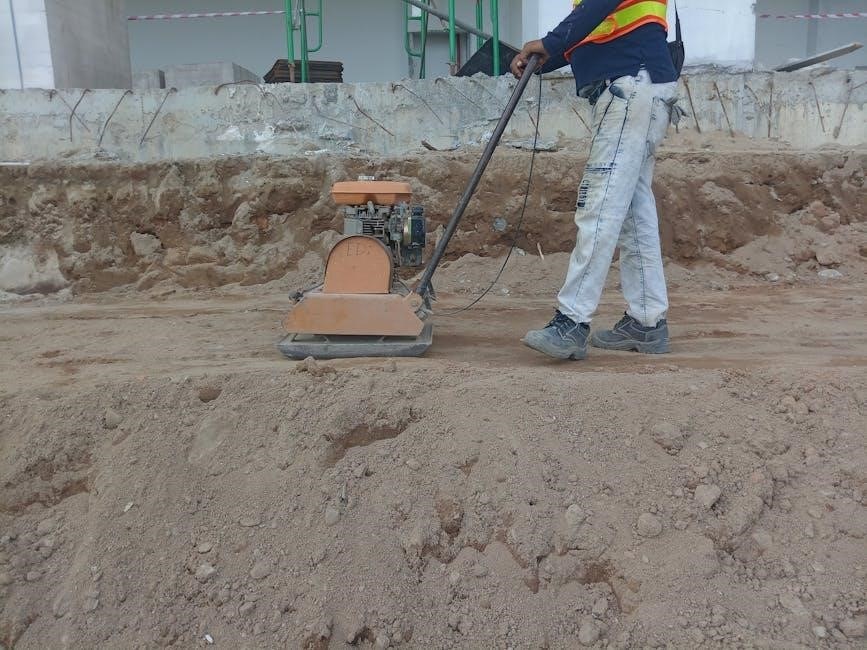Manual soil compaction involves densifying soil layers without machinery, enhancing stability and strength. Ideal for small-scale projects, it prevents settling and erosion, ensuring a durable foundation.
1.1 Importance of Soil Compaction
Soil compaction is essential for creating stable and durable ground structures. It improves soil strength and load-bearing capacity, reducing the risk of settling or shifting over time. Proper compaction prevents waterlogging and erosion, ensuring better drainage and root growth in gardens. In construction, it provides a solid foundation for buildings, paths, and other structures, enhancing safety and longevity. Manual compaction is a cost-effective and eco-friendly method for small-scale projects, offering precise control and minimal disturbance to the surrounding environment. By understanding and applying effective techniques, individuals can achieve professional-grade results without specialized machinery.
1.2 Brief Overview of Manual Methods
Manual soil compaction employs simple tools to achieve effective results. Common techniques include using a hand tamper, foot stomping, and water-based compaction. Hand tampers are versatile tools that apply even pressure to the soil surface. Foot stomping relies on repetitive tamping using body weight, ideal for small areas. Water-based methods involve soaking the soil to optimize moisture levels, enhancing compactability. These methods are cost-efficient and suitable for small-scale projects, requiring minimal equipment but consistent effort. Proper execution ensures uniform density and stability, crucial for foundation work and gardening. Each method has unique benefits, making them adaptable to various soil types and project requirements.

Understanding Soil Types and Their Compaction Needs
Understanding soil types and their properties is crucial for effective compaction. Each type has unique needs, ensuring optimal results through manual methods.
2.1 Clay Soil Characteristics
Clay soil is highly cohesive and has a fine texture, retaining moisture well. It becomes plastic when wet and hard when dry. Compacting clay requires careful moisture control, as excessive water can make it sticky and resistant to densification. Proper compaction enhances stability, reducing settling and improving load-bearing capacity. Manual methods, like tamping, are effective for small areas. Overworking clay can disrupt its structure, so controlled effort is essential. Achieving optimal compaction ensures a solid foundation for various applications, making it a critical step in construction and landscaping projects involving clay-rich soils.
2.2 Sandy Soil Properties
Sandy soil consists of large, coarse particles with low cohesion, making it prone to settling and erosion. It drains water quickly but lacks the binding properties of clay. Compacting sandy soil requires consistent effort to press the grains together, enhancing stability and load-bearing capacity. Unlike clay, sandy soil is less sensitive to moisture but benefits from slight dampening to improve compaction results. Manual techniques, such as tamping or foot stomping, are effective for densifying sandy layers. Proper compaction reduces air pockets and prevents shifting, ensuring a firmer base for construction or landscaping projects. Regular checks and maintenance are essential to maintain its integrity over time.
2.3 Loamy Soil Attributes
Loamy soil is a balanced mix of clay, silt, and sand, offering excellent drainage, water retention, and fertility. It is ideal for compaction due to its cohesive properties and ability to hold together well when pressed. Unlike sandy soils, loamy soil retains moisture effectively, which aids in achieving optimal compaction. However, it requires careful handling to avoid overcompaction, which can disrupt its structure and reduce fertility. Manual methods like tamping or foot stomping work well, as they apply consistent pressure without damaging the soil’s natural composition. Mixing compost or organic matter into loamy soil can further enhance its compaction and support plant growth, making it a versatile choice for various projects.

Preparing the Soil for Compaction
Clear debris, level the surface, and ensure optimal moisture levels for effective manual compaction. Proper preparation ensures uniform density and prevents structural issues in the compacted soil.
3.1 Clearing Debris and Vegetation
Before compacting, remove all debris such as rocks, twigs, and roots. Vegetation must be completely cleared to ensure even density. This step prevents uneven surfaces and air pockets, ensuring the soil is ready for effective compaction. Proper site preparation is crucial for achieving optimal results and preventing future structural issues.
3.2 Leveling the Ground Surface
After clearing debris, the next step is leveling the ground to ensure an even surface. Use a rake or shovel to redistribute soil evenly, creating a uniform base. Check the surface with a spirit level or string lines to ensure it is perfectly horizontal. Remove any high spots and fill low areas, compacting as you go. This step is crucial for achieving proper compaction and preventing future settling issues. A well-leveled surface ensures stability and optimal drainage, making it essential for both gardens and construction projects. Proper leveling also helps in achieving consistent soil density, which is vital for the success of your project.

Tools and Materials Needed
Essential tools include hand tampers, plate compactors, and garden rakes. Materials like sand or gravel may be added to improve soil stability and drainage.
4.1 Hand Tools for Compaction
Hand tools are crucial for manual soil compaction; A hand tamper is essential, featuring a flat, heavy plate for pressing down soil. It’s ideal for small areas and precise control. For larger spaces, a manual plate compactor can be used, though it’s more labor-intensive. Garden rakes help in leveling and loosening soil before compaction. Additionally, shovels and trowels assist in preparing and smoothing the surface. These tools ensure effective compaction without machinery, making them perfect for DIY projects or tight spaces.
4.2 Materials for Optimal Results
Using the right materials enhances manual soil compaction. Topsoil is essential for creating a stable base, while compost improves soil structure and moisture retention. Sand or gravel can be added to heavy clay soils to increase drainage and reduce compaction challenges. Water is crucial for achieving the optimal moisture level, as overly dry or wet soil complicates the process. Additionally, mulch can be incorporated to stabilize the surface post-compaction. Mixing these materials properly ensures a solid foundation, making the compaction process more effective and long-lasting for various applications like pathways or garden beds.

Manual Compaction Techniques
Manual compaction involves using tools like hand tampers or foot stomping to densely pack soil, ensuring a stable and even surface for various projects, enhancing durability and strength.
5.1 Using a Hand Tamper
A hand tamper is a simple, effective tool for manual soil compaction. It typically features a flat, heavy steel plate attached to a handle. To use it, firmly press the tamper down onto the soil surface, applying even pressure. Repeat this process in overlapping sections to ensure full coverage. For optimal results, use the tamper on moist soil, as this reduces air pockets and improves density. Regularly check the surface to maintain even compaction, especially in areas with loose or uneven ground. This method is ideal for small-scale projects and tight spaces where larger equipment cannot reach.
5.2 Foot Stomping Method
The foot stomping method is a basic and accessible way to manually compact soil. Simply moisten the soil to reduce air pockets, then firmly stomp on the surface with your feet. Wear sturdy footwear for better pressure application. Focus on overlapping areas to ensure even compaction. This technique is effective for small-scale projects or garden beds, where heavy equipment isn’t feasible. While it’s labor-intensive, it provides a cost-free solution for achieving stable ground. Repeat the process several times until the desired firmness is reached, ensuring the soil is evenly packed without overcompacting.
5.3 Water-Based Compaction
Water-based compaction is a simple yet effective method for manually compacting soil. Start by lightly watering the soil to increase its density. Use a hand tamper or your feet to press down, ensuring the water helps reduce air pockets. Avoid overwatering, as this can lead to instability. After compacting, allow the soil to dry slightly to achieve optimal firmness. This technique is particularly useful for clay-rich soils, as moisture enhances their ability to bind together. Regular checks post-compaction ensure the surface remains even and stable, making it ideal for garden paths or small construction projects where machinery isn’t practical.

Assessing Soil Moisture
Assessing soil moisture is crucial for effective manual compaction. Proper moisture levels ensure optimal density and prevent overcompaction, which can weaken soil structure and stability.
6.1 Testing Moisture Levels
Testing soil moisture is essential for manual compaction. One effective method is the hand test, where a small soil sample is squeezed. If it holds shape without crumbling, moisture levels are ideal. Another technique involves creating a shallow hole and observing water absorption rate. Slow absorption indicates optimal moisture, while rapid absorption suggests the soil is too dry. Additionally, the drop test can be used—forming a small ball of soil and dropping it from waist height. If it retains its shape, moisture is sufficient; if it crumbles, more water is needed. Proper moisture ensures effective compaction and prevents structural issues.
6.2 Adjusting Moisture for Compaction
Adjusting soil moisture is critical for effective manual compaction. If the soil is too dry, lightly water it and mix thoroughly. If too wet, allow it to dry slightly or add absorbent materials like sand. Ideal moisture creates a damp, moldable consistency without excess water. After adjusting, wait about an hour for the soil to absorb moisture evenly. Proper adjustment ensures the soil compacts uniformly, avoiding over-saturation or brittleness. This step is vital for achieving stable and durable results in manual compaction projects, especially for construction or landscaping applications.
Safety and Precautions
Wear protective gear like gloves and boots to prevent injuries. Avoid overexertion and ensure tools are handled safely. Maintain a stable working environment to prevent accidents.
7.1 Protective Gear
Protective gear is essential for manual soil compaction to prevent injuries. Wear sturdy gloves to safeguard hands from blisters and cuts. Steel-toe boots protect feet from heavy tools. Safety glasses or goggles prevent eye injuries from debris. A dust mask minimizes inhalation of soil particles. Long sleeves and pants reduce skin exposure to sharp objects. Ensure proper footwear traction to avoid slips. A first-aid kit should be nearby for emergencies. Proper gear ensures safety and comfort during manual compaction tasks, allowing you to work efficiently without risking harm. Always prioritize protective equipment to maintain a secure working environment.
7.2 Avoiding Overcompaction
Overcompacting soil can lead to reduced water infiltration and root growth, negatively impacting plant health. To avoid this, monitor compaction progress and stop once the desired density is achieved. Use a hand tamper or foot stomping sparingly, applying even pressure without excessive force. Sandy soils are more prone to overcompaction, while clay soils can become brittle. Ensure the surface remains flexible and permeable. Regularly check moisture levels to prevent over-drying. Proper technique and knowing when to stop are crucial to maintaining soil health and functionality. Avoiding overcompaction ensures a stable yet breathable base for gardens or construction projects, preserving soil integrity for years to come.

Tips for Effective Compaction
Apply even pressure, use layered soil, and maintain optimal moisture. Utilize hand tampers or foot stomping for small areas, ensuring consistent density without overcompacting for lasting stability.
8.1 Layering Soil
Layering soil involves spreading and compacting thin layers to achieve uniform density. Start with a base layer, compact it using a hand tamper or foot, then add successive layers. This method prevents air pockets and ensures stability. Each layer should be 2-4 inches thick, depending on soil type. Moisturize each layer before compaction to enhance cohesion; This technique is particularly effective for small-scale projects, ensuring a solid foundation without heavy machinery. Regularly check thickness and density to maintain consistency, promoting long-term durability and preventing settling or shifting over time.
8.2 Using Weight
Using weight is an effective method for manual soil compaction. Tools like hand tampers or heavy objects apply pressure to compress the soil. For small areas, a homemade weight, such as a filled tire or heavy board, can be dragged or pressed. Moist soil responds best, as water reduces friction between particles. Apply weight evenly, focusing on high-traffic zones. Repeat passes until desired density is achieved. This method enhances stability and prevents settling, especially in cohesive soils like clay. For larger areas, consider renting a plate compactor, which combines weight and vibration for superior results. Proper technique ensures long-lasting compaction.

Troubleshooting Common Issues
Identify and address issues like air pockets or uneven surfaces. Break up clods, redistribute soil, and re-tamp. Ensure proper moisture levels and check for hidden debris.
9.1 Dealing with Air Pockets
Air pockets in compacted soil can weaken its structure. To address this, gently break up the soil surface with a fork or spade, ensuring even distribution. Compact again using a hand tamper or foot-stomping method. Proper moisture levels are crucial; if the soil is too dry, it may crumble, while overly wet soil can trap air. After re-tamping, water lightly and allow it to settle before final checks. Regularly inspecting the surface and edges helps prevent air pockets from forming. This ensures a stable and even base for further construction or landscaping projects, enhancing durability and safety.
9.2 Managing Uneven Surfaces
Uneven surfaces can compromise the stability of compacted soil. To address this, use a shovel or trowel to redistribute soil to low-lying areas. Check moisture levels to ensure optimal compaction. Employ a hand tamper or foot-stomping method to flatten the surface. For larger uneven areas, mark high spots with stakes and compact layer by layer. Regularly inspect the surface with a spirit level or straightedge to ensure evenness. If necessary, add small amounts of soil to fill gaps and compact again. Properly managing uneven surfaces ensures a uniform base, preventing structural issues in future projects like pathways or foundations.

Maintaining Compacted Soil
Regularly inspect compacted soil for signs of settling or erosion. Water lightly and re-tamp as needed to maintain stability. Prevent erosion with mulch or vegetation cover;
10.1 Regular Checks
Conduct regular inspections of compacted soil to ensure its integrity. Look for cracks, unevenness, or soft spots. Check after rainfall or heavy use. Establish a routine schedule to monitor soil conditions. Address any issues promptly. Use a hand tamper to re-compact areas showing signs of settling. Maintain even moisture levels to prevent drying out or waterlogging. Keep records of inspections and maintenance activities. Early detection of problems prevents costly repairs later. Regular checks ensure the soil remains stable and supports its intended use effectively over time. Consistency is key to preserving the quality of manually compacted soil.
10.2 Preventing Erosion
Preventing erosion is crucial for maintaining the integrity of compacted soil. Apply a layer of organic mulch, such as grass clippings or wood chips, to protect the surface. Plant vegetation with deep roots to stabilize the soil. Avoid overcompaction, as it can lead to water runoff. Install retaining walls or barriers in sloped areas to prevent soil displacement. Ensure proper drainage by creating shallow channels or swales. Regularly inspect and reinforce edges to prevent crumbling. Use geotextiles or mesh for added stability in high-risk zones. Maintain consistent moisture levels to avoid cracking and erosion. These measures ensure long-term soil stability and prevent erosion effectively.

When to Seek Professional Help
Consult professionals for large-scale projects or complex soil types requiring specialized equipment. Expertise ensures proper compaction and safety, especially for deep or engineered soil applications.
11.1 Large-Scale Projects
Large-scale projects, such as industrial construction or extensive landscaping, often exceed manual methods’ capabilities. These tasks require heavy machinery like rollers or plate compactors to efficiently cover vast areas. Manually compacting large spaces is time-consuming and may not achieve uniform density. Hiring professionals ensures the use of specialized equipment tailored to the project’s needs, optimizing both time and results. Additionally, they handle complex soil types and deep compaction requirements more effectively. For such scenarios, seeking expert assistance is crucial to meet structural and safety standards, avoiding potential issues like uneven settling or instability in the future.
11.2 Specialized Equipment Needs
When manual methods are insufficient, specialized equipment becomes necessary for effective soil compaction. Tools like plate compactors, rollers, and vibratory tampers are designed for deep and uniform densification. These machines handle large areas quickly and efficiently, ensuring optimal results. Rental options are often cost-effective for single projects, while purchases may be warranted for frequent use. Professionals typically have access to a broader range of equipment tailored to specific soil types and project requirements. Investing in or renting the right machinery ensures that compaction goals are met, especially for complex or demanding tasks beyond manual capabilities.
Manual soil compaction is a practical and effective technique for small-scale projects. By understanding soil types, preparing the ground, and using appropriate tools, one can achieve a stable and durable foundation. Regular checks and maintenance ensure long-term success. For larger tasks, considering professional help or specialized equipment is wise. This guide provides a comprehensive approach to manual compaction, empowering individuals to handle soil projects confidently and efficiently.